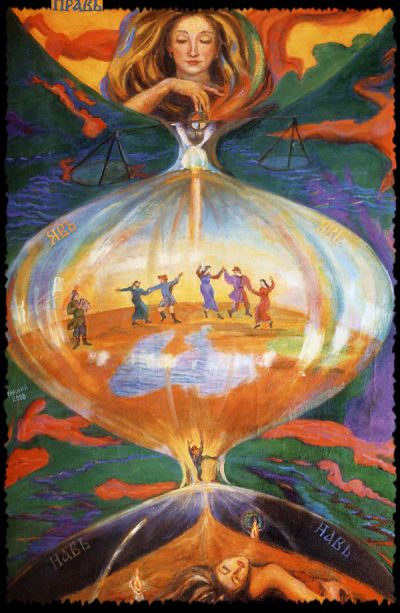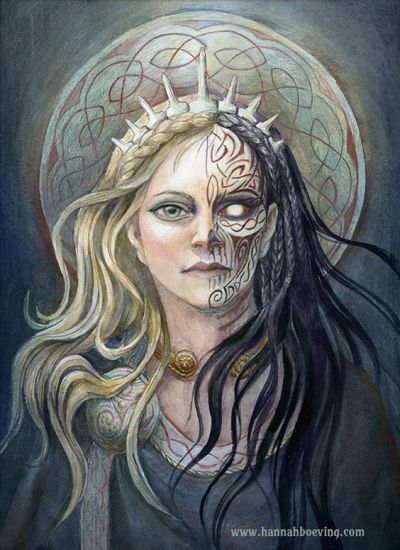Bem-vindo aos nossos novos jogadores brasileiros. Por favor leia
Kraestret Religion
From Sanctuary Shard
The people of Kraestret were never truly devout followers of the Thorn King, instead, like most things in their culture, only what a god or goddess would do for them was important. During the two millennia that the Thorn King was in power, the people of Kraestret did as was expected of them for weekly services and privately still turned to local shrines set up to near-forgotten heroes and spirits. It would not be until Queen Daciana placed Yrsa-as-Hel upon the Arcanum Crystals would a countrywide religion become established.
World Tree
Like that of Midrvegr, the people of Kraestret have a world tree as the center of their belief system. Yav-Prav-Nav is very similar to Yggdrasil which is found in Midrvegr. "Yav" The world around us is located at the middle of the World Tree the trunk. "Prav", the Upper world is the realm of heavenly deities and celestial bodies. "Nav", the underworld, is located in the roots of the World Tree. The legends of the tree retained their importance through the Thorn King Era for it was the tree that aspiring shamans climbed in order to gain their magical powers.
Yrsa-as-Hel
A post Ragnorok alternate pantheon
In a world much like that of earth, there came a young goddess by the name of Yrsa. She was born of two Vanir, Freyr (The Lord) and Freya (The Lady), the children of Njord, a northern sea god. Yrsa, a young godling, fond of the Alfar to whom she was their princess, and the Jotunn by whom she was secretly raised, came to hate the cruel treatment done to Tyr, the god of law, once the father of all. She was a very young girl when his hand was bitten off by Fenrir, chained by Odin, and she wept that the great beast was shackled and chained.
She was only fourteen summers when she led those of the Alfar and the Jotunn east of the sun and west of the moon, far into northern frozen Helheim. Tyr, the lawful one, went with her, and when she, Yrsa, was trapped in Helheim by the goddess Hel, Tyr lead their people down into the new lands of where they settled.
Yrsa, still a child would grow into her power in the lands of Helheim, she would eventually trap and overpower Hel, binding the power of two death goddesses together. Her mother’s legacy gave the young godling the right to claim half of those fallen in battle. With the union forged in Helheim, Yrsa now a grown woman would truly become battle maiden and crone. Hel/Yrsa would take on their iconic image of half beautiful woman and half aging hag.
In her role as Hel, Yrsa she returned to the lands of the Aesir to free Fenrir from his chains, thus bringing about Ragnarok in those lands. She would put the chains on Odin, and call him Grimnar, the shadow one, so that Fenrir might drag the Aesir All-Father about as he wished. She would pass again through Helheim, and come down into the lands of Midrvegr to rejoin her people.
She would take to her bed Njordr, the reborn sea-god, and the ancient-lawful-one Tyr, as husbands. With the power of Fenrir, and the chained Grimnar she would come fully into her power as battle maiden, fertility mother, and death crone.
Veles
The people of Kraestret were hit particularly hard by the forced conversion to that of the Thorn King. In the last 70 years there has been a trial of return to many different gods previously worshiped by the people, or perhaps still worshiped under the noses of the Thorn King priests. One of the most popular gods of the pre-Thorn King Era was that of Perun, a powerful thunder god. Unfortunately, as things go, there were many relationships established between that of the Andal god and Perun -- the people had little trust any longer for their once beloved god.
When their queen, Daciana, brought the goddess Yrsa-as-Hel to the capital in Drokkburg most were skeptical and the worship remained that of the court only. But the people of Kraestret understand that a god is only as useful as he is powerful and when the Dragons left Midrvegr they said, “This goddess must be powerful that she had the power to drive out the dragons, what will she do for us if we give her our worship?”
This would begin a subtle shift in the last few months where local clerics would begin to move aside the collections of idols on their altars and place only Yrsa-as-Hel. The villagers began to claim that she was a great battle goddess and chooser of the slain, a goddess of the underworld that would free those caught in the shackles of death by the Thorn King. The people of Kraestret, like those of Midrvegr, worship their ancestors, and much worry was had to where their ancestors would be found.
In a place, not too far from the capital, in a small village, a cleric terrified for the loss of the crops placed the idol of Veles beside Yrsa-as-Hel. Veles was once the opponent of Perun, and demonized during the era of the Thorn King. But Veles was a god of the cattle, and therefore wealth. A fertility god with ties to the underworld and the bears and wolves and other beasts of the moon. It would be shortly after this act that a late crop would bloom in the village.
It did not take long for the story to spread; for the people were hungry for good news. In a short time idols to Veles would be placed beside that of Yrsa-as-Hel and the two would be wedded in the minds of the people. Veles was seen as fitting husband to Yrsa-as-Hel and would soon replace most of the stories of Fenrir and Grimnar which were told in the far east. Soon it would be commonly held that the triple goddess had three husband, and in her guise as Hel it was Veles who stood beside her and protected the people of Kraestret.
Surely Veles shares some commonalities to the Horned God of Raeyithia and the Lord Freyr of Midrvegr, Yrsa’s father, but Veles more then the other two is a far more powerful god with broad aspects that cover all the these things plus the power of magic and ritual, the dark sea, and the deep woods. He is considered by many to be Yrsa’s equal and a worthy opponent of Perun-as-Thorn King, may he never again reign.

